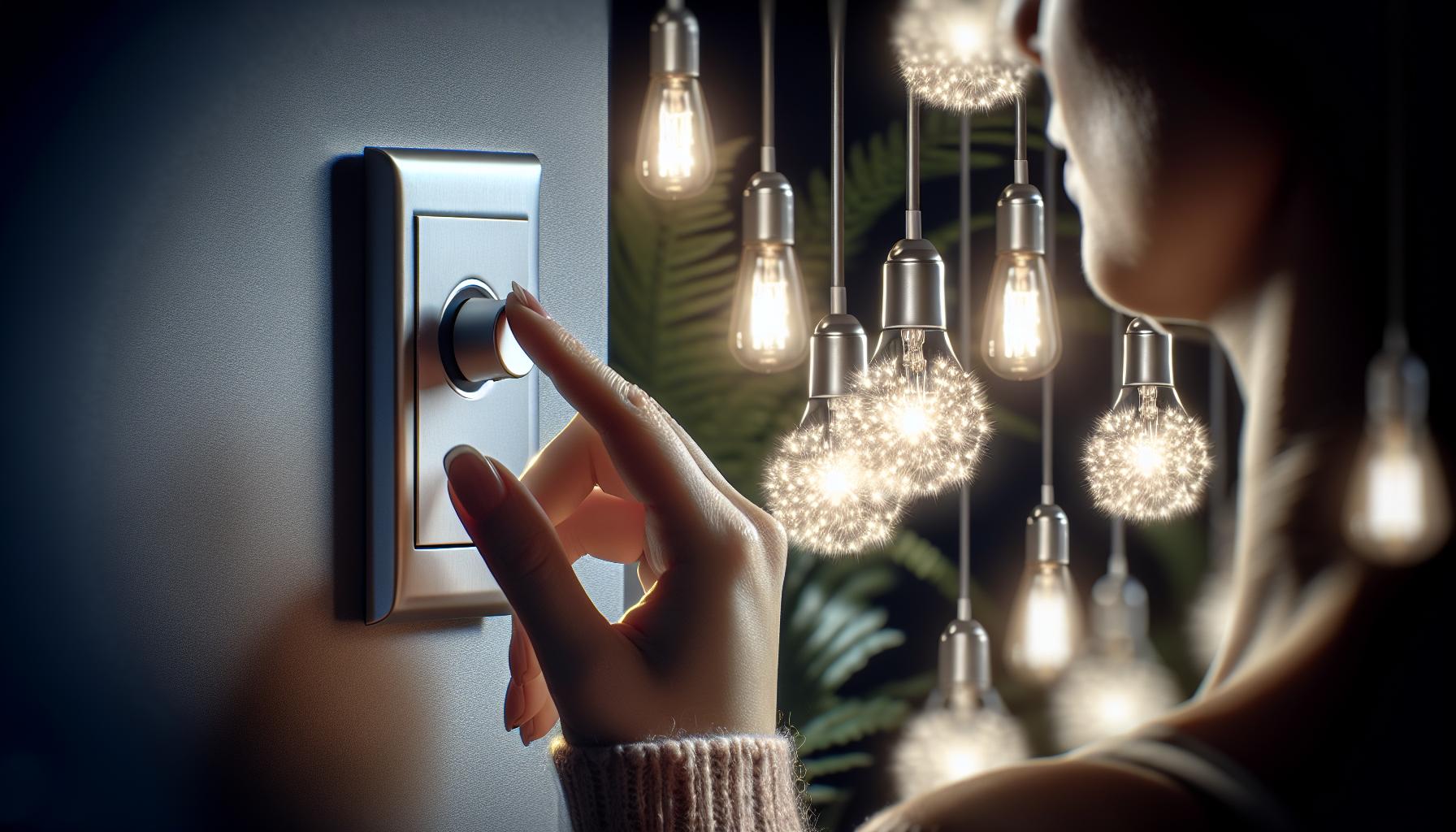Ever found yourself squinting under the harsh glare of a light bulb, wishing you could just dial it down a notch? Or maybe you’ve longed for a bit more brightness while curled up with a good book. Enter the world of adjustable lighting, where 3-way light bulbs and dimmable lights promise to give you control over your room’s ambiance. But are they really the same thing?
You might think that a bulb’s a bulb, but when it comes to setting the right mood, the type of light you choose can make all the difference. Let’s shed some light on the topic and find out if 3-way bulbs and dimmable options are interchangeable, or if they’re as different as night and day.
Understanding 3-way light bulbs
Imagine you’ve just stepped into a room and flicked on the light switch. With 3-way light bulbs, you’re met with a unique ability to alter the room’s brightness just by turning the same switch another time or two. These bulbs have a distinct configuration that allows for three different light levels from a single light source. So, how does this magic happen?
Inside a 3-way bulb, there are two filaments of differing wattages. When you first turn on the lamp, the lower-wattage filament lights up, emitting a soft glow. A second flip of the switch engages the higher-wattage filament, resulting in a brighter light. And when you’re aiming for maximum illumination, a third toggle activates both filaments together.
To harness the adeptness of 3-way light bulbs, you’ll need a compatible lamp or fixture. These are specifically designed with 3-way sockets and switches that work in tandem with the bulb’s structure. Remember, the enchanting step-up or step-down lighting effect won’t happen with just any lamp.
Here’s a comparison detailing the levels of brightness you might expect from a typical 3-way bulb:
| Setting | Wattage | Luminance |
|---|---|---|
| Low | 50W | Cozy, soothing |
| Medium | 100W | Bright, clear |
| High | 150W | Vibrant, vivid |
While the concept of 3-way bulbs seems straightforward, remember these bulbs are not the same as their dimmable counterparts. Instead of offering a smooth transition across a spectrum of brightness, the 3-way system provides set stages of light—a feature perfect for those who love precise control without needing a dimmer.
Throw in the ease of installation and you’ve got yourself a lighting solution that’s both versatile and user-friendly. You can change the ambiance of your room without the added hassle of installing dimmer switches or special fixtures.
Next time you’re contemplating a lighting upgrade for your reading nook or home office, think about whether the clear-cut adjustments of a 3-way bulb fit your vision. Keep in mind that creating just the right atmosphere might be all about finding that perfect mid-ground without the gradual dimming that other options offer.
Exploring dimmable light options
When you’re looking to set the perfect ambiance in your space, understanding dimmable light options is key. Unlike 3-way bulbs that step between three set levels of brightness, dimmable bulbs offer a seamless transition, allowing you to adjust light intensity to your exact preference.
Most dimmable lights work with a wide range of dimmer switches which can be easily incorporated into your existing electrical setup. This compatibility gives you the freedom to adjust the lighting in various rooms of your home to create the desired mood or increase energy efficiency. However, it’s crucial to pair your dimmable bulbs with the right dimmer switch to avoid flickering or reduced lifespan of the bulb.
LED technology has revolutionized the dimmable lighting scene. Not only do LED dimmable bulbs consume less power, but they also have a longer lifespan compared to their incandescent counterparts. To make sure your LED bulbs dim properly, you’ll need a compatible LED dimmer switch since traditional dimmers may not work as smoothly with LEDs.
For those of you who love DIY projects, installing a dimmer switch can be a weekend task that significantly enhances your living space. If you’ve ever wanted the versatility of dimming without the hassle of rewiring, plug-in dimmer adapters are a simple solution. They plug right into your outlet, allowing you to dim lamps without any complicated installation.
« What Is Best Light Bulb for Living Room? Illuminate with Top Picks
What Light Bulbs Produce the Least Heat? Discover the Coolest Options for Your DIY Projects »
Smart bulbs present another incredible option for dimmable lighting. These high-tech bulbs can be controlled via smartphone apps or voice commands through smart home systems. The customization options are almost limitless, allowing you to schedule brightness levels throughout the day and even change light colors if the bulbs have RGB capabilities.
So while 3-way bulbs are great for static level choices, if you’re looking for fluidity and continuous control over your lighting, exploring dimmable light options might be just what you need to elevate your home’s atmosphere. Whether through upgraded switches, energy-efficient LEDs, or the wonders of smart technology, perfect lighting is at your fingertips.
Differences between 3-way bulbs and dimmable lights
When you’re knee-deep in a home DIY project or refining your space’s ambiance, understanding the nuances between 3-way bulbs and dimmable lights can be pivotal. While both options provide flexibility in lighting, they approach the task differently.
3-way light bulbs are designed to emit three distinct levels of light — low, medium, and high. It’s like having three separate bulbs in one. These bulbs achieve their varying intensities thanks to their unique internal structure which houses two filaments of different wattages. To toggle between brightness levels, you’ll need a 3-way lamp that comes with a special socket and switch.
In contrast, dimmable bulbs allow for a continuous range of brightness, giving you fine control over the light output. It’s not just low, medium, and high – it’s whatever level suits your mood or need at the moment. The crucial component for dimmable lights to work is a compatible dimmer switch, which adjusts the power delivered to the bulb.
To put it into perspective, here’s a quick breakdown:
- 3-Way Bulbs: Work with three brightness settings and require a special 3-way lamp.
- Dimmable Lights: Offer a smooth transition between brightness levels and need a dimmer switch.
While 3-way bulbs stick to their designated three settings, dimmable lights offer you a continuous spectrum, like a volume slider for your lighting. This means that if you’re after precision and the ability to tweak brightness to the exact level you want, dimmable lights are the way to go.
Moreover, LED dimmable bulbs bring additional benefits. They are energy-efficient and have a longer lifespan than traditional bulbs, including most 3-way options. Enhancing their appeal, LED bulbs are available in a range of color temperatures, ensuring that you can set not just the right brightness but also the correct tone to suit any room’s décor and atmosphere.
Remember to always ensure that your dimmable LEDs are compatible with your chosen dimmer switch, as not all dimmers work with all types of LED bulbs. The harmony between the bulb and the switch is key to achieving your desired lighting effect without flickering or reduced lifespan.
Factors to consider when choosing between the two
When you’re standing in the lighting aisle, pondering whether to go for a 3-way bulb or a dimmable light, several factors scream for your attention. It’s not just about flipping a switch; it’s about setting the right mood, saving energy, and, let’s be honest, flaunting a bit of that home DIY savvy.
Firstly, consider the fixture in question. Your lamp or light fixture might be the deciding factor here. If you’re eyeing that elegant lamp on your desk, check if it’s designed specifically for a 3-way bulb. These lamps are built to handle the three distinct levels of lighting – low, medium, and high. It’s the fixture’s way of going ‘Hey, I’m exclusive’ to standard bulbs.
Switch over to dimmable lights, and you’re playing a different game. These bulbs play nice with a wider range of fixtures, but – not to burst your bubble – you’ll need a compatible dimmer switch. Without the right switch, your plans for a perfectly dimmed ambiance might flicker out.
Next up, think about the level of control you crave. If you’re satisfied with three clear-cut settings, a 3-way bulb has your back. But if you dream of a finely-tuned glow, then the continuous range of a dimmable light will make your heart skip a beat.
Energy efficiency is another heavy hitter. Nowadays, LED dimmable lights steal the show here, with a lifespan that makes traditional bulbs look like a flash in the pan. LEDs are champs at keeping your electricity bills low and your spirits high. So you might want to factor in those long-term savings.
Lastly, don’t forget ambiance. What’s the vibe you’re gunning for? A romantic dinner, a well-lit study session, a dimly lit movie night? Your choice will dictate the bulb you buddy up with.
Remember, your lighting sets the stage for every moment in your home. Make it count. Settle on the combination that suits your lifestyle and lights up your world just right.
Pros and cons of 3-way light bulbs and dimmable lights
3-Way Light Bulbs: A Triple Advantage
Imagine having the ability to switch up the lighting intensity without installing a separate dimmer switch. That’s where 3-way bulbs shine. You’ve got:
- Flexibility: Simply twisting your lamp switch lets you adjust between low, medium, and high settings.
- Convenience: No additional installations mean the ease of use right out of the box.
- Ambiance: Set the mood from your reading nook to a cozy ambient space with just a flick.
However, 3-way bulbs also come with their trade-offs:
- Special Hardware: You’ll need a compatible 3-way lamp, and these specific fixtures might limit your style choices.
- Limited Variability: You’re confined to three settings versus the gradual variability offered by dimmable lights.
Dimmable Lights: Gradual Glow
Dimmable lights are the go-to for tailor-made lighting. Your perks include:
- Precise Control: Achieve the exact brightness level you need with a dimmer switch.
- Energy Efficiency: Dialing down the light saves energy and can reduce your electric bill.
- Extended Bulb Life: Dimming can prolong the life span of your bulbs, offering long-term savings.
On the flip side, dimmable lights require:
- Compatible Technology: You’ll need both dimmable bulbs and a compatible dimmer switch.
- Installation: Setting up dimmer switches might call for some DIY prowess or the help of an electrician.
- Cost: The initial investment is higher due to the cost of dimmable bulbs and the switch.
Whether you lean towards the straightforward nature of 3-way bulbs or the customization offered by dimmable lights, your choice ultimately hinges on your lifestyle. As a lighting enthusiast and DIY aficionado, you’re equipped to make an informed decision that casts your home in the best light. Keep in mind these pros and cons as you light up your living space.
Conclusion
You’ve seen the unique benefits that both 3-way light bulbs and dimmable lights offer. It’s clear that they each shine in their own ways, whether it’s the simple mood-setting ability of a 3-way or the precise control of a dimmer. Your choice hinges on what you value most in your home’s lighting—be it convenience, energy savings, or the flexibility to adjust ambiance with ease. Remember, lighting plays a key role in the comfort of your space, so choose the option that aligns best with your lifestyle and illuminates your world just the way you like it.
Frequently Asked Questions
What are the benefits of 3-way light bulbs?
3-way light bulbs provide flexibility in lighting intensity and can help set the right mood in a room. They are also convenient as they can be adjusted without a dimmer switch, but require a compatible 3-way lamp.
Can 3-way light bulbs work in any lamp?
No, 3-way light bulbs require a lamp that is specifically designed to accommodate them. Using a 3-way bulb in a standard lamp will result in only one brightness level being available.
What are the advantages of dimmable lights?
Dimmable lights offer precise control over brightness levels, can contribute to energy savings, and may extend the bulb’s life due to reduced wear from operating at lower intensities.
Do dimmable lights need special technology?
Yes, dimmable lights require compatible dimmer switches and fixtures. The technology needed for dimmable lights also typically means a higher initial cost for equipment and installation.
How do I choose between a 3-way bulb and a dimmable light?
Your choice between a 3-way bulb and a dimmable light should be based on your specific lighting needs, lifestyle, and readiness to invest in compatible technologies for dimming functions.





